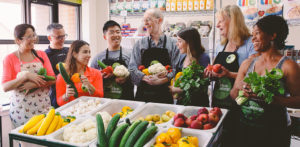Feed your heart

It’s no longer news to anyone, with the pandemic and the crisis unleashed by it, Food Banks have registered a sharp increase in demand. Even now, with the economy showing signs of recovery, the exponential increase of some basic products, essential to feed a family, leads many to stop being shy and knock on the door of one of the Food Banks spread across Canada.
In fact, as Henry Chiu, Director of Development & Marketing at North York Harvest Food Bank, said: “we have seen a 40% increase compared to the same period pre-Covid”.
In the middle of this festive season, the lives of many are left hanging by a thread – some (too many) without reasons or food to celebrate. It’s disturbing to know that this reality exists, right next to us – at least for all of those who have their hearts in the right place. In fact, we don’t know what will happen tomorrow and nothing guarantees that it won’t be us, right there, one day, without the basics to live, much less to celebrate on a night that should be beautiful for all.
In this regard, we were duly enlightened by the information given by Sacha Michna, Senior Manager, Community Partnerships and Events at Daily Bread Food Bank: “We are seeing a significant increase in new clients who have never had to use a food bank before”.
There are many in need of help, but there are also many available to help. And there could be many more.
Maria Rio, Director of Development and Communications at The Stop Community Food Centre, explains that, at this moment, more than food,“what really helps right now is financial support”.
Here’s a challenge – how about giving yourself a gift? Have the pleasure of knowing that with your generosity you’ve made someone’s Christmas a bit happier.
Milénio Stadium: Have you experienced an increase in demand for help?
Sacha Michna: We’ve seen an unprecedented increase in food bank usage since the pandemic began. This year, there were close to 1.45 million food banks in Toronto, the highest number of visits ever recorded in the city’s history, and an increase of 47% compared to the year prior. In November 2021, food bank visits reached a record-breaking high, with over 126,000 visits to Daily Bread member food banks in a single month.
MS: How are you doing on donations during this festive season?

SM: For our 2021 holiday campaign, Daily Bread Food Bank has set an ambitious goal of raising $9.5 million and collecting 569,000 lbs of non-perishable food donations. We have seen an outpouring of support from the community this holiday season, but with food bank usage higher than it’s ever been, we are still in need of financial and food donations to help ensure that our neighbours experiencing hunger across the city can continue to access fresh, nutritious food. Visit our website at dailybread.ca to learn more about the different ways you can help.
MS: For those who want to donate, what types of food are most needed?
SM: Our most needed non-perishable items are plain rice; proteins like peanut butter, canned fish/meat, and legumes; canned fruits and vegetables; soups and stews; and baby food and formula. A full list of most needed items can be found on our website at dailybread.ca.
MS: As it is very close to Christmas, is there a difference in the service you provide compared to the rest of the year?
SM: Daily Bread Food Bank operates year-round. We’re certainly busier during the holiday season, and especially this year as the pandemic continues, but our core service remains the same. For anyone in need of food during the holiday season, be sure to check with your local food bank to see if their hours of operation are impacted by the holidays.
MS: Nowadays, and after another year of the pandemic, which age group is the most in need of your help?
SM: We are seeing a significant increase in new clients who have never had to use a food bank before. Over the past year, there has been a 61% increase in new client clients compared to the year prior. Three out of four new clients reported coming to a food bank due to the impacts of COVID-19, many of whom lost their employment or have seen reduced hours. We have also seen an increase in the number of children and youth accessing food banks across the city. Currently, close to one in three food bank visits in Toronto are children and youth, compared to one in four prior to the pandemic.
The Stop Community Food Centre
Milénio Stadium: Have you experienced an increase in demand for help?
Maria Rio: The Stop took on an additional location at the end of 2019, just a few months before the pandemic began. In comparison to pre-pandemic/pre-new location, we are serving almost 30% more meals through our take-away programs at 1884 Davenport and 729 St. Clair – around 431 on average every day we are open. This year, we are projecting we will have served almost 80,000 before the end of the year, which is about 40% more than pre-pandemic/pre new location, but only 5,000-10,000 more than last year, so not a huge jump during the past year.

In our food bank, we have experienced a jump tied only to the pandemic. The Stop has seen an increased need for hampers, with many families coming from outside our catchment area; we’ve ultimately decided to increase access to our food bank by offering hampers 2x per month (up from 1x) to a larger audience across the GTA. We hand out an average of 1000-1200 food hampers a month, each hamper going to a household of one to nine people.
We have also seen our expenses increase as there is less food being donated. We’ve seen a 22% decrease in donated food as larger groups cannot gather to host food drives throughout the pandemic. With increased demand as well, our food expenses have gone up by 35%. Additionally, we’ve been preparing hampers with much fewer volunteers to ensure social distancing, so we have less help in the kitchen and food bank.
MS: How are you doing on donations during this festive season?
MR: Donations are coming in, but they do not match what came in during the beginning of the pandemic – March/April 2020, and last Christmas. People saw COVID as a huge emergency that would have a huge negative effect on the most needy community members, and they are right. Unfortunately, that urgency has gone away as COVID continues to be a problem, but for some of our community members, the effects are much worse now than at the beginning of the pandemic. For example, in our program for new and expecting mothers, 65% of our program participants reported losing significant income in June 2021, up 20% from the 45% who reported significant income loss in September of 2020.
Our community of donors is still giving very generously, but we need to have more emergency support to match the needs of the emergency; even government COVID supports have decreased by hundreds of thousands of dollars.
MS: For those who want to donate, what types of food are most needed?
MR: We appreciate people want to donate food, but what really helps right now is financial support. We do not have as many volunteers on site due to social distancing so we cannot sort all the items the way we could before. We also make hundreds of hampers and meals, so to make them equal, culturally-appropriate, and healthy, we often have to source our own products. Charities can also get discounts when we buy things in bulk, so by providing us with financial support you are helping us get our community access to food that is culturally relevant, fresh produce, and in line with their various dietary needs and requirements.
MS: As it is very close to Christmas, is there a difference in the service you provide compared to the rest of the year?
MR: Due to COVID, our services have been in emergency mode. We would often gather together and have big holiday meals, but this year we are doing take-away holiday meals. This is what those look like this year:
Friday Dec. 17th: Latin American holiday meal @ 1884
Chicken pozole verde, totopos and pico de gallo, tres leches cake
Tuesday Dec.21st: Solstice lunch @ 1884
· Fry bread tacos, Three sisters’ soup with cornmeal dumplings and wild blueberry cake
Wednesday Dec.22: Healthy Beginnings Holiday lunch @ 1884 and Solstice lunch @ WOD
(1884) Roast chicken, spelt berries with mushrooms, roasted root veggies and holiday cookies
(WOD) Stew beef with squash, beans and corn, Bannock biscuit with jam
Thursday Dec.23: Holiday Turkey Lunch @ 1884 (Turkey, etc), Holiday Dinner @ WOD (more turkey, 4-5pm!)
· (1884 lunch) Turkey, mashed potatoes, gravy, biscuits, veggies, individual apple pies
· (WOD dinner) Turkey, cheddar mashed potatoes, cornbread stuffing, creamed greens, gingerbread cookies
Friday Dec.24: Holiday Brunch @ 1884 10am to 12pm (no breakfast/lunch this day, just one meal)
· Oatmeal pancakes, bacon, eggs, fruit salad and cinnamon buns
Friday Dec.31: Kwanza lunch @ 1884
· Stew beef, coconut rice, plantain, coleslaw and sweet potato pone
MS: Nowadays, and after another year of the pandemic, which age group is the most in need of your help?
MR: We do provide a lot of meals to seniors through our 729 St. Clair location, and have seen an increase of 15% in youth under 18 being served at our food bank. We do help everyone get access to good food at our locations, but have noticed those two trends during COVID.
Milénio Stadium: Have you experienced an increase in demand for help?
HC: Before the pandemic, North York Harvest was already experiencing a 9% year over year increase and the pandemic certainly accelerated that rise in demand. In fact, we have seen a 40% increase compared to the same period pre-Covid.
MS: How are you doing on donations during this festive season?

HC: The awareness of food insecurity has heightened during these challenging times and the community has fully demonstrated its generosity. It’s their contributions that enable us to sustain our work.
MS: For those who want to donate, what types of food are most needed?
HC: During the holiday seasons, the community tends to be very generous in donating food and organizing food drives. And, we do see a collection of many most-needed except for a few. In particular, we can use more cooking oil and small bags of rice.
MS: As it is very close to Christmas, is there a difference in the service you provide compared to the rest of the year?
HC: Our programs are closed in the last week of December so our frontline staff can take some much deserved time off. To accommodate the closure, we are providing our clients additional food for the missed service. We’ll go back to our regular schedule in the first week of January.
MS: Nowadays, and after another year of the pandemic, which age group is the most in need of your help?
HC: One of the trends among new clients is that we are seeing more families (vs single person households) needing emergency food. That means more children are being impacted. At the same time, the fastest growing segment is seniors for reasons such as fixed income, mobility and health.
Catarina Balça/MS








Redes Sociais - Comentários